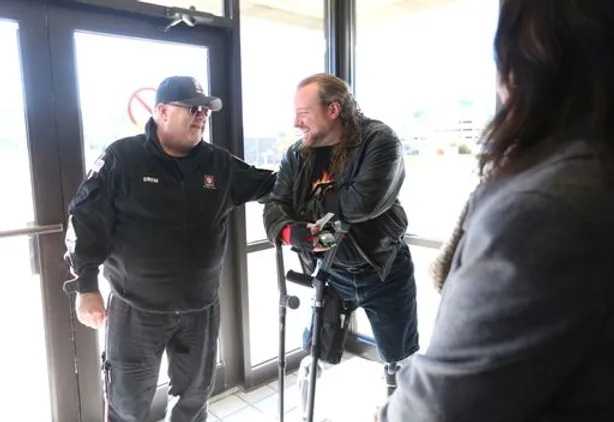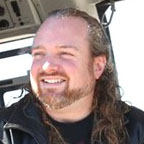This blog post was originally posted on the Walking Spirit blog on October 13, 2023, in support of National Disability Employment Awareness Month (NDEAM).
(Image Description: Jeremy Warriner, a bi-lateral above knee amputee stands on two prosthetic legs with the aid of two crutches attached to his forearms, which are crossed in front of him. He has long reddish-brown hair falling loose over his shoulders. He is wearing a black leather jacket, a black t-shirt with a flame image, and denim shorts. He has a short-trimmed red beard and is smiling at an older gentleman standing to his right. They are standing in front of a pair of glass doors with windows surrounding them letting in bright daylight. The older gentleman is wearing gray pants, a black IU Health Lifeline jacket, aviator sunglasses, and a gray baseball cap. He is smiling and reaching out to Jeremy with his left arm, patting him on the back. The picture is taken over the left shoulder of a dark-haired woman in the foreground).
We’re fast approaching the 18th anniversary of my survival day; the day I lost both of my legs to severe burns sustained in a car accident during my commute home from work but did not die. October 22nd marks that life altering event for me. It’s been 18 years, and the irony that this happened during National Disability Employment Awareness Month is just hitting me.
Including my college education, I had spent over a decade of my life focused on a career in full-service hotel management. I had experience working for multiple management firms exceeding the standards set by the dominant hotel brands in the hospitality industry. I had the training, and facilitated much of the training, provided by these brands and management firms. I knew March was National Disability Awareness Month, but with all of that time engaged with national and multi-national employers and their various human resources offices, I had not heard of Disability Employment Awareness Month…or, if I had, it had not been given any attention or significance.
To put this into perspective, I did not become aware of National Disability Employment Awareness Month until after I became a person with a disability who was trying to adapt to maintain employment. That’s not really the way it’s supposed to work, though it is not surprising. People with disabilities often get overlooked and represent a largely underutilized, though often highly effective part of the workforce. Despite national efforts to promote employment of people with disabilities dating all the way back to 1945, when Congress passed a law establishing the first week of October as “National Employ the Physically Handicapped Week” which also requested an annual Presidential proclamation. (It’s interesting to note that this minimal social dawning of awareness came so many decades before the Americans with Disabilities Act protected our civil rights to employment).
Understanding that people with disabilities have always been a diverse minority within our culture, one that actually links all other cultures together, it’s staggering how lack of innovation has been a barrier to access, inclusion, equity, and belonging for people with disabilities throughout our history. Employment of People with Disabilities leads to innovation in the way we find different ways to achieve the same goal by asking the question “how can a person with _____ disability achieve the primary function of ______ job?” The more you think outside of the box, the more you promote innovation, which ultimately enhances productivity and improves the bottom line. Employing people with disabilities is a motivator for this process.
Apparently in 1945, someone in the US Congress started to get it. The fact that we got a week at that point, along with an annual Presidential proclamation, was a win. It didn’t stop there. In 1947 President Truman established a committee responsible for coordinating and publicizing events to celebrate the week. In 1949 Congress appropriated funding for the committee and in 1954 they were directed to work with state and local authorities to promote job opportunities for the “physically handicapped”. In 1955 they became a permanent organization.
Recognizing that people with intellectual and developmental disabilities could, and should, be able to work too, just like people with physical disabilities, in 1962 President Kennedy renamed the committee the “President’s Committee on Employment of the Handicapped”. This executive order also significantly expanded their charge by directing them to develop employment opportunities for both the “physically and the mentally handicapped”. Congress then re-designated the first week of October as National Employ the Handicapped Week”.
Though it was the social term of choice, the term “handicapped” has always had a negative connotation and represents people with disabilities as a social burden. People with Disabilities have worked diligently to remove this word as an identifier for our minority. Perhaps showing sensitivity to this, in 1988 President Reagan issued an executive order renaming and reorganizing the committee into the “President’s Committee on Employment of People with Disabilities”. Congress then expanded and renamed “National Employ the Handicapped Week” to make the month of October “National Disability Employment Awareness Month”.
Before, during, and after the civil rights movement in the United States, people with disabilities have been fighting for their right to employment and inclusion in society. We had a week from 1945 to 1988, then we got a month, then in 1990 we got the five titles of the ADA starting with Title 1 which protects people with disabilities from discrimination based on their disability in regard to all aspects of employment. Yet, when I was a student in the mid ’90’s earning my bachelor’s in Consumer and Family Sciences with an emphasis on Hospitality and Tourism Management, the ADA was barely touched on during my Hospitality Law class.
Throughout my career in the hospitality industry, there was minimal focus placed on employment of people with disabilities. No exploration of the benefits that come from hiring people with disabilities, like innovation in the work environment and reduced turnover. Little to no disability awareness training for management or line level staff…despite the fact that disabilities affect over a quarter of the world’s population, which absolutely impacts the service experience and interaction with employees and customers alike.
On rare occasions the properties that I would manage might contract with a local service provider who helped people with disabilities find work. More often than not this would be a group home or a day center for people with developmental disabilities. They would bring a group of people with disabilities to work for our housekeeping and culinary departments, usually helping with public area cleanliness in the bathrooms, hallways, lobbies, washing dishes, mopping floors, and/or helping in the laundry. These groups would come with a job coach from their organization who was there to support the employee.
Rarely did we see people with physical disabilities through these agencies. When a person with a physical disability did apply for a job, we would interview them, but I don’t remember any training about what we could or could not ask in the interview. I never received any training on how to ensure that we were not discriminating against candidates with disabilities when comparing them against other candidates without visible or disclosed disabilities. If we had any connections to resources to help us with employing people with disabilities and modifying jobs and work environments as needed, I was not aware of them.
Before I became a person with a disability, I never stopped to consider the training that should have happened when we contracted with disability employment and support organizations. Any time the employee had an issue, the department supervisor would look to the job coach to handle it. Instead of communicating with the employee, the hotel staff preferred to work through the job coach, and more often than not, the job coach allowed it. This did nothing to help the employment relationship between the actual employee and their supervisor.
We employed people with disabilities to fill the jobs we had difficulty filling but didn’t want to understand their needs. Not once did I ever receive any training to understand how Autism, Down Syndrome, Cerebral Palsy, ADHD, or any other disability might affect the way an employee receives instruction or needs to modify their process to achieve the primary function of the job. How disabilities might impact guest interaction, whether on the part of the employee, the consumer, or both was never a consideration. Our corporate human resources offices encouraged us to hire people with disabilities because of the tax break the property would receive, not because it was the right thing to do or the best way to fill vital jobs, reduce turnover, and promote innovation. Now, mind you, this was my experience between 1993 and 2008, when I left the hospitality industry to pursue disability advocacy and public speaking. One would hope that there has been improvement over almost two decades, but I’m led to believe that it has been minimal compared to other concepts of diversity.
Since that time Diversity, Equity, and Inclusion have become the major buzz words in the Human Resources realm of corporate business and culture. Diversity hires are a win, Equitable treatment and pay are major selling points, and Inclusion in the business decision making process builds a sense of Belonging for everyone…which has become the newest buzzword added to “DEI” or “DEIB”. Except, once again, disability tends to get overlooked because “it’s a part of diversity, right?”
Disability is unique, because while disabilities are a part of diversity, people with disabilities can’t be included in your diversity unless you are Accessible first. Employment of people with disabilities as a constant, vital, equitable, and inclusive part of your team helps to ensure that you are actually able to achieve those DEIB goals by adding the “A” to truly create Accessible Diversity, Equity, Inclusion, and Belonging for employees and consumers of your operation.
Why does Disability Employment Awareness get a month? Because people with disabilities are vital to the future life of all operations that function in the public sector as both employees and consumers. People with disabilities are also vital employees to have in state, local, and federal government, as these are often the people whom those services support. Why does Disability Employment Awareness get a month? A better question is why doesn’t Disability Awareness Employment get every month?
 About the Author
About the Author
Jeremy Warriner (he/him) is a consultant in accessibility, hospitality management, and outreach. Based in Indianapolis, he’s a motivational speaker with a focus on Disability Awareness: Finding Strength in Traumatic Events.


 About the Author
About the Author